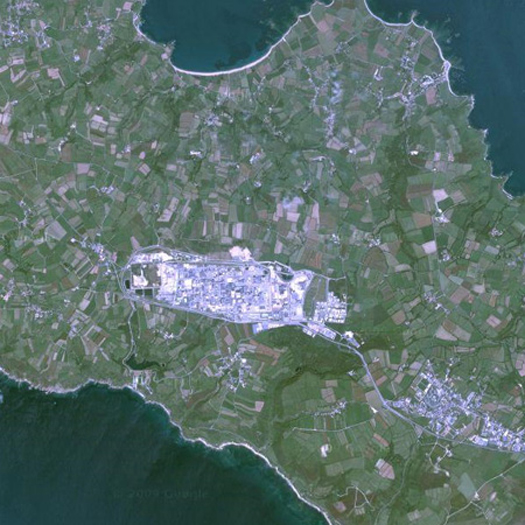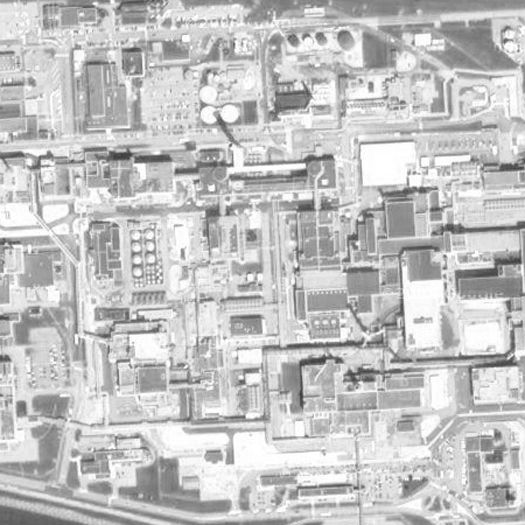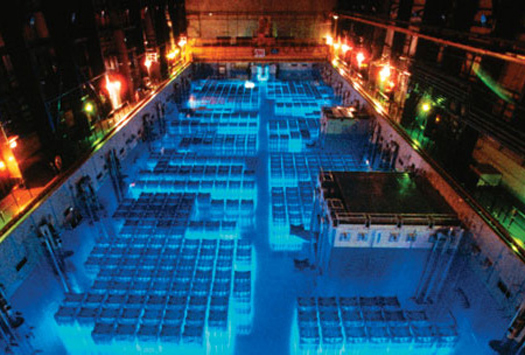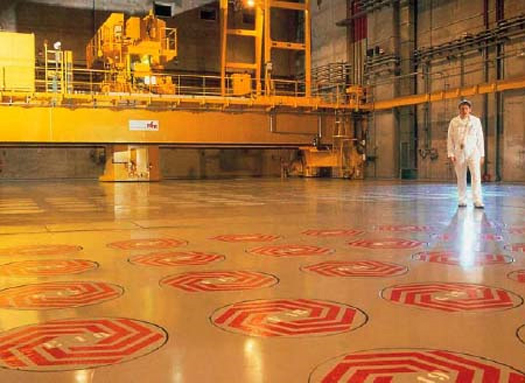The French keep all of the nuclear waste from the last thirty years of energy production in one room, the storage vault at La Hague.


If, as the landscape theorist Beth Meyers has suggested, sublime sentiments can be stirred by the juxtaposition of knowledge of invisible danger with the regimented beauty of industrial architecture, then this gymnasium-sized room (and, by extension, perhaps the whole of La Hague) might be the most sublime place on the planet.
I was alerted to the existence of this room by a single sentence in an article on Infrastructurist about the closing of the Yucca Mountain facility. The author of that article, William Tucker, has written at length about the French nuclear program; but it is his description of a tour of La Hague which fascinates me:
And suddenly, there it is before us. Like some benthic organism being hauled out of the deep, a complete fuel assembly is slowing rising out of the floor, lifted by an overhead crane, until it reaches the full height of the room. With its steel frame and vertical black lines – the fuel rods – it looks eerily like a miniaturized version of the World Trade Center. Yet its blank and featureless face has the soulless menace of a shark’s eye.
“What’s the radiation coming out of that thing?”
Naugnot consults quickly with a nuclear engineer who speaks only French.
“Un million millirads,” says the engineer. A million millirem. Quick calculation -that’s 1000 rems. The highest exposure people got standing near ground zero at Hiroshima was only 500 rems. This is truly the most powerful and dangerous material on earth. Yet here we are, perfectly shielded by a foot of lead-laced glass. If we suffer the slightest exposure, the full-body radiation detectors will catch it when we leave.
…
“How long has it been since someone was in that room?”
“Not since it was built. And they won’t be in there again until years after it’s decommissioned. If you walked in there now, you’d be killed instantly.”
I have not been able to locate a image of that first room, which may not be a bad thing for the purposes of this post, as I suspect that being able to see the space — and its apparent emptiness — would likely trick the mind into thinking it less threatening than it really is. Better to imagine it as an invisible yellow hole than to see a photograph which cannot capture the flood of radiation.
The second room is bathed in an gorgeous blue glow — the visible signature of Cerenkov radiation from stacked spent fuel, held harmless underwater.

The next stop is the “swimming pool,” a larger version of the storage pools that hold spent fuel at almost every nuclear plant. This one is near-Olympic size. The blue Cerenkov glow is fainter, giving it the color of one of those horrible kids’ kool-aid flavors. As we scan the perimeter I suddenly see something wildly incongruous and yet perfectly appropriate – life preservers hanging about every twenty yards along the guardrail – a perfect conjunction of high- and low-tech.
The water is apparently so effective at neutralizing the radioactivity of the spent fuel that Tucker tells the French tour guide of American nuclear plant workers who have snuck illicit swims in storage pools — though Tucker gives the impression that he is not entirely convinced by those claims.
The final room — home to all thirty years of nuclear waste — is anticlimactic, after the described power of the first room and the vivid reminder of the atomic forces in play provided by the Cerenkov radiation in the second. But this is the glistening heart of La Hague:

It is a bit larger than I imagined. Somehow I had seen it as about the size of a small visitors’ center. Instead it is more like a large basketball gymnasium. Still, it’s one large room. In the floor there are about 40 manhole covers stenciled with Areva’s triangular logo. All are so tightly sealed with no visible handles it seems impossible they could ever be removed.
more
::Article discussing the process at La Hague as well as the trade-offs involved in reprocessing spent fuel (as is done at La Hague).
::This post originally appeared on eatingbark.

